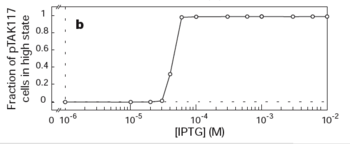Difference between revisions of "CellularMemory:Toggle Switch"
Wideloache (talk | contribs) |
Wideloache (talk | contribs) (→Specific Biological Design) |
||
| Line 8: | Line 8: | ||
==Specific Biological Design== | ==Specific Biological Design== | ||
| − | [[Image:TogglePlasmid.png|thumb|300px|right|'''Figure 1: Biological design of a genetic toggle switch | + | [[Image:TogglePlasmid.png|thumb|300px|right|'''Figure 1:''' Biological design of a genetic toggle switch]] |
Figure 1 on the right shows the specific configuration of the two plasmid constructs that were used, each of which confers cellular memory. Each of the plasmids consist of two promoter/repressor pairs, one of which is the P<sub>trc</sub> promoter and the lacI repressor (inhibited by IPTG). P1 and R1 represent the second promoter/repressor pair that was used in conjunction with P<sub>trc</sub> and lacI. Plasmids with the P<sub>L</sub>s1con promoter and the temperature sensitive lambda repressor as their second promoter/repressor pair were referred to as pTAK constructs. Plasmids with the P<sub>L</sub>tetO-1 promoter and the tetR repressor (inhibited by aTC) were referred to as pIKE constructs. Multiple types of each plasmid design were constructed by modifying the ribosomal binding site strength of the repressor genes. The constructs were capable of toggling between “on” and “off” stable steady states of GFP production through exposure to a repressor-inhibitors (IPTG, 42 degrees C, or aTc). In this way, the plasmids were able to “remember” the most recent inhibitor that was in their environment | Figure 1 on the right shows the specific configuration of the two plasmid constructs that were used, each of which confers cellular memory. Each of the plasmids consist of two promoter/repressor pairs, one of which is the P<sub>trc</sub> promoter and the lacI repressor (inhibited by IPTG). P1 and R1 represent the second promoter/repressor pair that was used in conjunction with P<sub>trc</sub> and lacI. Plasmids with the P<sub>L</sub>s1con promoter and the temperature sensitive lambda repressor as their second promoter/repressor pair were referred to as pTAK constructs. Plasmids with the P<sub>L</sub>tetO-1 promoter and the tetR repressor (inhibited by aTC) were referred to as pIKE constructs. Multiple types of each plasmid design were constructed by modifying the ribosomal binding site strength of the repressor genes. The constructs were capable of toggling between “on” and “off” stable steady states of GFP production through exposure to a repressor-inhibitors (IPTG, 42 degrees C, or aTc). In this way, the plasmids were able to “remember” the most recent inhibitor that was in their environment | ||
[[Image:linebreak.png]] | [[Image:linebreak.png]] | ||
Revision as of 18:26, 5 December 2007
Main Page | Biological Designs | Mathematical Models | Toggle Switch | Hysteresis | Permanent Memory | Conclusions | References
|



